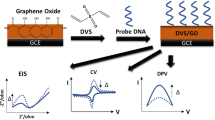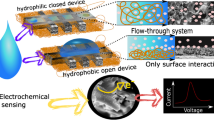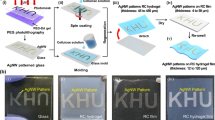Abstract
We present the immobilization of DNA on a high aspect-ratio glassy carbon microelectrodes patterned using standard photolithography techniques and fabricated from pyrolyzed negative-tone photosensitive polymer, and their subsequent electrical characterization as part of a new bionanoelectronics platform. The 3D glassy carbon microelectrode architecture introduced here consists of mainly high aspect-ratio microelectrode structures (>20 μm height) with amide bond between the carboxylated glassy carbon electrode and aminated λ-DNA bridge suspended between two electrodes. The use of these glassy carbon electrodes patterned through lithography and derived from the pyrolysis of negative-tone resist polymers (hence called GC-MEMS) as opposed to the commonly used metal electrodes offers advantages of an inert carbon electrode surface that is resistant to non-specific binding of salts—an issue that has plagued most λ-DNA attachment experiments reported in the literature. The results demonstrate the ability to immobilize DNA on the surface or generate a DNA bridge between to GC-MEMS electrodes using oxygen plasma functionalization and carbodiimide crosslinking with aminated oligonucleotides. We also discuss in detail (1) the effect of concentration of reactants, (2) pH of the crosslinking reaction, and (3) the use of electrokinetic mixing in promoting DNA attachment on this GC-MEMS platform.





Similar content being viewed by others
References
Alivisatos AP, Johnsson KP, Peng X, Wilson TE, Loweth CJ, Bruchez MP et al (1996) Organization of ‘nanocrystal molecules’ using DNA. Nature 382:609–611
Braun E, Eichen Y, Sivan U, Ben-Yoseph G (1998) DNA-templated assembly and electrode attachment of a conducting silver wire. Nature 391(6669):775–778
Choi EY, Han TH, Hong J, Kim JE, Lee SH, Kim HW, Kim SO (2010) Noncovalent functionalization of graphene with end-functional polymers. J Mater Chem 20(10):1907–1912
Di Felice R, Porath D (2008) DNA-based nanoelectronics. In: NanoBioTechnology: bioinspired devices and materials of the future. Springer, New York
Hassan S and Asghar M (2010) Limitation of silicon based computation and future prospects. In: Proceedings of the second international conference on communication software and networks, IEEE Computer Society, Washington, pp 559–562
Hirabayashi M, Mehta B, Vahidi NW, Khosla A, Kassegne S (2014) Functionalization and characterization of pyrolyzed polymer based carbon microstructures for bionanoelectronics platforms. J Micromechanics Microengineering 23(11):115001
Kassegne S, Reese H, Hodko D, Yang J, Sarkar K, Smolko S et al (2003) Numerical modeling of transport and accumulation of DNA on electronically active biochips. J Sens Actuators B Chem 94(81–98):81–98
Kassegne S, Wondimu B, Mazjoub M, Shin J (2008) High efficiency microarray of 3-D carbon MEMS electrodes for pathogen detection. In: Proceedings of SPIE, Optomechatronic Technologies, vol 7266
Mirkin C, Letsinger R, Mucic R, Storhoff J (1996) A DNA-based method for rationally assembling nanoparticles into macroscopic materials. Nature 382:607–609
Mucic RC, Storhoff JJ, Mirkin CA, Letsinger RL (1998) DNA-directed synthesis of binary nanoparticle network materials. J Am Chem Soc 120:12674
Porath D, Bezryadin A, de Vries S, Dekker C (2000) Direct measurement of electrical transport through DNA molecules. Nature 403(6770):635–638
Seeman NC (1982) Theory of structural DNA nanotechnology, nucleic acid junctions and lattices. J Theor Biol 99:237–247
Seeman NC (1991) The use of branched DNA for nanoscale fabrication. Nanotechnology 2:149–159
Shoseyov O, Levy I (2008) NanoBioTechnology: bioinspired devices and materials of the future. Springer
Triberis GP, Dimakogianni M (2009) DNA in the material world: electrical properties and nano-applications. Recent Pat Nanotechnol 3(2):135–153
Vahidi NW, Hirabayashi M, Mehta B, Rayatparvar M, Wibowo D, Ramesh V, Kassegne S (2014) Bionanoelectronics platform with DNA molecular wires attached to high aspect-ratio 3D metal microelectrodes. ECS J Solid State Sci Technol 2014:Q29–Q36
Wang C, Taherabadi L, Jia G, Kassegne S, Zoval J, Madou M (2004) Carbon-MEMS architectures for 3D microbatteries. In: Proceedings of SPIE, vol 5455, pp 295–302
Acknowledgments
The authors would like to thank Dr. Steve Barlow of SDSU Electron Microscopy Facilities for use of the fluorescent microscope.
Author information
Authors and Affiliations
Corresponding author
Rights and permissions
About this article
Cite this article
Hirabayashi, M., Mehta, B., Nguyen, B. et al. DNA immobilization on high aspect ratio glassy carbon (GC-MEMS) microelectrodes for bionanoelectronics applications. Microsyst Technol 21, 2359–2365 (2015). https://doi.org/10.1007/s00542-014-2332-3
Received:
Accepted:
Published:
Issue Date:
DOI: https://doi.org/10.1007/s00542-014-2332-3




